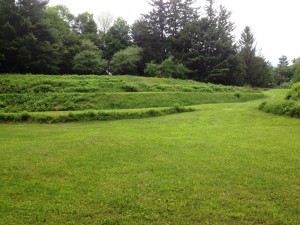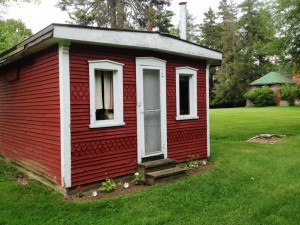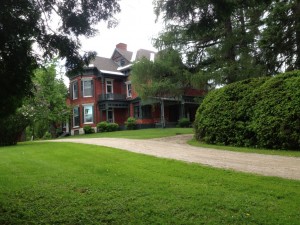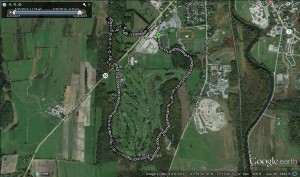Still in recovery mode from a long race over Memorial Day weekend, I opted for a very short run on the much traveled “Red Kelly Trail”, the trail which circles the Middlebury College Championship Golf course, also known as “Augusta National‘s Little Brother”. Well, we aren’t exactly having Georgia weather of late, but you get the picture. I have talked about the sights on this trail on numerous occasions, most recently on a longer run incorporating the Red Kelly Trail about two years ago. Not a lot has changed since then, except for the fact that the section of the trail across the west ridge (or alongside the 10th fairway for those who know the course) has been rerouted away from the course and onto its own separate trail, where runners are more protected from errant tee shots. If even a small fraction of the golfers are as miserable with their drivers as I have been, this re-route will probably save lives!
So, I departed the Middlebury College athletic facilities on South Main St. and got onto the Kelly Trail directly behind the all-weather “Kohn” Athletic Field. Yes, everything on the campus is indeed named after someone! After completing most of the trail in the clockwise direction, as I neared the end of the trail, I crossed South Main St. (aka Rt 30) and did the short descent on the Class of 97 Trail. After about a half mile or so on this pleasant little stretch of single track trail, I came to the point where it emerged from the forest into the more open fields below. Rather than continue on at this point, I elected to return, originally planning to retrace my steps back to Rt. 30. However, a few minutes into my return, I noticed an unmarked herd path heading uphill to my left, unceremoniously marked by the presence of a large tractor tire seemingly abandoned in the woods. Ascending this trail, it became apparent almost immediately where I was – the backyard of the mansion known as “The Heights” or “The Thaddeus Chapman House”. Many years ago, a member of the family which owns this property showed me around the interior of this large old home, and while it has not been regularly inhabited due to the high cost of heating it in the winter, it’s interior has been well maintained as a sort of museum to life in the late 1800’s. Searching for more information about this grand old house, I contacted my colleague, architechtural historian, Prof. Glenn Andres. From him, I learned that the house was built in 1870 by the owner of the Starr Mill, one Caleb Ticknor. The house was acquired by Chapman in 1875, who subsequently had it renovated in 1887 by architect Clinton Smith (the reknowned architect of the better known Shard Villa) into its current elaborate (that is as close as I can come to the real architectural terms like “Queen Anne” and “Italianate”) form
Despite my one previous foray onto this palatial property, I had never actually explored the grounds. Not seeing any “No Trespassing” signs from my point of entry, I decided to explore the grounds a bit on foot. One of the first sights I noted was the bermed amphitheater built into the back yard. Oral tradition holds (that is my fancy way of saying Glenn heard it, but can’t confirm) that these terraces were once the basis of elaborate gardens, while other oral traditions (a few generations of Middlebury College students) confirm that these terraces hold a long tradition as a college student trysting site in warmer weather.

Further up the hill from this, on the East Side of the main house, is a small childrens’ play house. Peering in through the window, I could discern child-size furniture indicating its use in its heyday.

Finally, leaving the property through the front driveway gave a nice vantage point to enjoy a good look at the main house.

The driveway brought me back to Rt 30, pretty much just across the street from the College field house, making this a short (slightly less than 3 miles!) but interesting run. Since the last section of this run is on private property, should you choose to explore The Heights, please be respectful of this well-maintained gem. Although it is usually not inhabited, this registered historic site is in no way a derelict property! If any reader has anything more recent to add to my bare bones story of this property, I would love to hear it!
